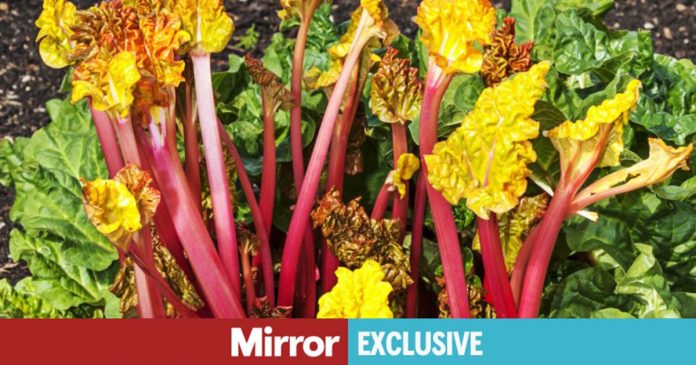Thanks to the sunniest March on record, we’re reportedly expecting a bumper crop of rhubarb and British asparagus. The prolonged warm weather created the perfect growing conditions for both crops and data from Ocado shows that British rhubarb sales are up 88 per cent year on year.
Online rhubarb recipe searches for rhubarb crumble were four times higher last week than a month earlier. But the sunny weather can also have unexpected effects on our rhubarb. One reader, Cathy, wrote to me with a photo of her rhubarb’s new flower stalk, asking me if this is normal.
This is called bolting when a plant such as rhubarb or lettuce produces flowers before you’ve had time to harvest it. It’s probably the result of the warm spell – the plant feels under stress and must reproduce quickly. The sooner you cut off the flowering stalk, the plant can put its energy back into stalk and leaf production. The stalks should still be fine to harvest.
Here’s my list of the other jobs gardeners can get on with this week:
Meanwhile, the trend for wildflower meadows has been blooming for nearly a decade now, and it’s more than just a passing fashion. As the importance of pollinators has finally sunk in, gardeners across the country have embraced the joy and purpose of sowing wildflower seeds. Those bold, flowering meadows – brimming with colour in the first year – have become a familiar sight in gardens, schools, verges and community spaces.
But while many enjoy spectacular results from the start, especially with pictorial annual meadows, it’s worth pausing – particularly now, in the middle of seed-sowing season – to reflect on what happens next. Creating a long-term, species-rich wildflower meadow takes time. The real magic comes not just in that first flush of blooms, but in watching a living system evolve over the years. Here’s what to expect from your meadow as it matures.
Your wildflower journey begins with a dazzling display. The first summer is often filled with brilliant blooms from fast-growing annuals – poppies, cornflowers, scented mayweed, corn marigold, and corncockle may all make an appearance. These early stars aren’t just eye candy; they play an important role in supporting the long-term meadow. Acting as a kind of ‘nurse crop’, they provide cover and protection for the slower-growing perennial and biennial species that are just starting to take root. Enjoy the show – these annuals will usually die back come autumn.
In the second year, the meadow changes character. The splashy annuals are mostly gone, and their place is taken by hardy biennials and a few quick-growing perennials. Oxeye daisies often dominate, creating a white daisy-dotted field in early summer. You may also see red campion or knapweed if they’ve established well. While it might look less dramatic than the first year, this phase is a crucial step in the meadow’s development, as underground roots and seedbanks quietly build strength.
This can be a quieter year for colour, but don’t be disheartened – it’s a sign of natural progress. The initial dominance of oxeye daisy or wild carrot often begins to fade, allowing space for a greater variety of wildflowers to emerge. The perennial species are now maturing, and the overall composition starts to shift towards a more balanced, long-term mix. Think of this year as the meadow finding its rhythm.
By year four, the meadow has settled. With the right management – such as annual cutting and removal of clippings to prevent soil enrichment – you’ll see a colourful blend of native wildflowers, flowering at different times throughout the summer. Each year from now on, your meadow can become even more diverse, welcoming new species and supporting a broader range of insects, birds, and pollinators.
The process of establishing a meadow is not instant, but it is deeply satisfying. Watching a space change and evolve over several seasons brings a unique joy. If you’re just starting out, now is the perfect time to prepare the ground and sow wildflower seeds.
Clear away existing grass and weeds, rake over the soil, scatter your seeds, and gently press them in. Then let nature take its course. A wildflower meadow is more than just a garden feature – it’s a small act of restoration. As it grows and settles, so too does your relationship with the seasons, the soil, and the natural world around you. And that, in the end, might be the most beautiful bloom of all.
A sea of blue spires is appearing in the borders. Camassia is a perennial bulb that grows happily in moist but well-drained soil and will multiply gently. The leaves are linear and grass like and the stems are covered in violet-blue star shaped flowers. Plant bulbs in autumn and introduce this low-maintenance beauty to your plot.
At Reach and across our entities we and our partners use information collected through cookies and other identifiers from your device to improve experience on our site, analyse how it is used and to show personalised advertising. You can opt out of the sale or sharing of your data, at any time clicking the “Do Not Sell or Share my Data” button at the bottom of the webpage. Please note that your preferences are browser specific. Use of our website and any of our services represents your acceptance of the use of cookies and consent to the practices described in our Privacy Notice and Cookie Notice.





